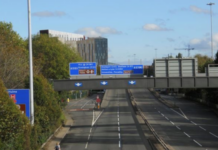The progress of the ever-changing Manchester skyline could come to a halt as a result of “lengthy delays” caused by the new Building Safety Act, according to a leading construction lawyer.
Several high-rise towers have sprung up in the city over the last decade, with Glenbrook having recently received the green light earlier to construct a 44-storey residential building that will provide 364 new homes in Whitworth Street West.
In recent years numerous other high-rise towers have been built in Manchester city centre and areas including Salford, the three highest in the city being the original Beetham Tower and newcomers Vista River Gardens and Deansgate Square South Tower – the tallest building in the UK outside London.
But Harriet Atkin, a partner in the construction team at national law firm Clarke Willmott LLP in Manchester, says the legislation introduced in the wake of the Grenfell Tower tragedy could halt the city’s high-rise trend in its tracks, impacting transactions and ultimately, the delivery of new homes.
“A decade or so ago, Manchester’s skyline looked very different,” she says.
“In recent years it has been transformed by the boom in high-rise construction and it’s now dominated by several very tall towers, with a further dozen high-rise office and residential blocks dotted around the city centre.
“All developers and building owners must now comply with the Building Safety Act and in relation to high rise residential buildings (buildings that are either 18 metres or higher, or has at least seven storeys, and contains at least two residential units) this entails navigating three critical safety ‘gateways’, initially at the planning stage, then before building work can commence and finally, before a building can be certified complete and then occupied.
“There was a phased introduction to this process but the problem now is that a bottleneck has built up due to a lack of resource, in particular at Gateways 2 and 3. The delay is also partly due to the Building Safety Regulator (BSR) receiving incorrect applications leading to avoidable rejections due to a lack of clarity on the requirements for achieving approval under the Gateways – the rejection is like the dreaded fall down the snake in the game of snakes and ladders, with rejected applications falling to the back of the queue.
“The BSR has said that it is planning to assist the current process by offering a new advisory service on how the functional requirements of the building regulations can be achieved. It has also confirmed they plan to employ more experts to further accelerate the response times.”
In the latest blow to developers, the BSR missed its April target to clear the backlog of Gateway 2 approvals. Latest figures reveal that over two-thirds of Gateway 2 applications transferred to the BSR last autumn, remain unapproved.
Harriet Atkin says additional pressure will also be placed on developers by the building safety levy, which requires them to contribute to the remediation of building safety defects, including replacing unsafe cladding.
“Currently, tall buildings are still going up in central Manchester, where square footage is at a premium, but the existing schemes are likely to have been approved some time ago.
“The city has seen a high-rise residential boom and the much-needed redevelopment of several run-down central areas but this could slow down noticeably now in view of the mounting pressures associated with the Building Safety Act.”
Harriet’s advice is that where the BSR fails to meet these specified timelines, the latest government guidance suggests that applicants should consider submitting a non-determination application to the Secretary of State (SoS) for Levelling Up and Housing.
This application is made under Section 30A of the Building Act 1984 and can be initiated by emailing [email protected]
If an application is deemed successful, the SoS is required to determine the developer’s original application or appoint someone to do so. However, it is crucial to note that there is no statutory timeframe within which the Secretary of State must act, potentially leading to a further lengthy and unenviable bureaucratic process with limited redress for applicants practically. So this is far from an ideal solution.
Given the above “mainstream” remedy is unlikely to achieve the desired outcome, in addition to addressing the associated risks of such delays from the outset within the relevant development agreement/buildings contract, it is recommended that all parties explore the more inventive options available.







